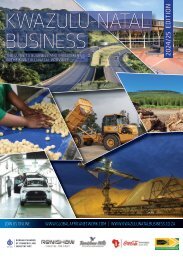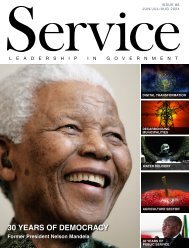Eastern Cape Business 2017 edition
The 2017 edition of Eastern Cape Business is the 10th issue of this highly successful publication that, since its launch in 2006, has established itself as the premier business and investment guide to the Eastern Cape Province. The Eastern Cape enjoys an abundance of natural and human resources, as well as established industrial infrastructure that drives the economy of the province. This includes three ports and two industrial development zones which are home to a wide range of manufacturers and exporters. The 2017 edition includes an in-depth look at the province’s two Industrial Development Zones, a focus on skills development and investment climate information from the Nelson Mandela Business Chamber and the Border-Kei Chamber of Business.
The 2017 edition of Eastern Cape Business is the 10th issue of this highly successful publication that, since its launch in 2006, has established itself as the premier business and investment guide to the Eastern Cape Province. The Eastern Cape enjoys an abundance of natural and human resources, as well as established industrial infrastructure that drives the economy of the province. This includes three ports and two industrial development zones which are home to a wide range of manufacturers and exporters.
The 2017 edition includes an in-depth look at the province’s two Industrial Development Zones, a focus on skills development and investment climate information from the Nelson Mandela Business Chamber and the Border-Kei Chamber of Business.
Create successful ePaper yourself
Turn your PDF publications into a flip-book with our unique Google optimized e-Paper software.
OVERVIEW<br />
The dorper breed (which are mainly used for meat production)<br />
is found in the dry Karoo, while the higher-lying areas are more<br />
conducive to the wool-producing sheep.<br />
South Africa produces about 50 000 tons of wool annually. In<br />
2014/15, the value of wool sold at auctions reached R3.5-billion; in<br />
2015/16 it was R3.7-billion, of which R815-million was generated in<br />
the <strong>Eastern</strong> <strong>Cape</strong>.<br />
The National Woolgrowers Association (NWGA) has helped<br />
24 000 <strong>Eastern</strong> <strong>Cape</strong> communal wool farmers get organised into<br />
1 224 wool growers associations. Now they have access to<br />
sheds with good equipment for shearing and classification.<br />
(www.heatherdugmore.co.za)<br />
One of the support programmes aims to improve the genetic<br />
stock. This is funded by the national Department of Rural<br />
Development and Land Reform and involves communal farmers<br />
swopping an inferior ram for a good ram. So far, 42 000 good merino<br />
rams have been added to the communal flocks.<br />
Dugmore’s report highlights the achievements of a group of<br />
communal farmers from the Sterkspruit district, near the Lesotho<br />
border. The 66 farmers of the Upper Telle shearing shed were the<br />
2015/16 season NWGA Grand Champions. Their 5 600 sheep produced<br />
an average of R92.03/kg against the national average for<br />
commercial wool farmers of R77.40/kg. The average for communal<br />
wool farmers is R52.35.<br />
The South African Mohair Growers Association is based in the<br />
heart of Angora goat country at Jansenville while the industry association,<br />
Mohair South Africa, has recently built smart new headquarters<br />
in Port Elizabeth, encompassing a shop and conference<br />
facilities. South Africa produces about half of the world’s mohair.<br />
Processing of mohair takes place in Uitenhage, Port Elizabeth<br />
and Berlin outside East London. The mohair value chain includes<br />
brokers, buyers, processors,<br />
spinners, manufacturers and<br />
retailers. The Stucken group<br />
controls Mohair Spinners South<br />
Africa, Hinterveld (a mill) and<br />
a processing company called<br />
Gubb & Inggs in Uitenhage.<br />
Several agricultural companies<br />
have mohair divisions:<br />
OVK (based in Ladybrand) has<br />
a 34% shareholding the <strong>Cape</strong><br />
Mohair Wool (CMW), a mohair<br />
brokerage; BKB (Port Elizabeth<br />
headquarters) has a mohair division<br />
that includes auctions and<br />
brokering.<br />
Other livestock<br />
Livestock farming is the largest<br />
agricultural sub-sector in South<br />
Africa. The <strong>Eastern</strong> <strong>Cape</strong> holds<br />
21% of the country’s cattle (about<br />
3.2-million), 28% of its sheep<br />
(seven-million) and 46% of its<br />
goats, making it the largest livestock<br />
province by a large margin.<br />
The rich natural grasslands<br />
of the <strong>Eastern</strong> <strong>Cape</strong> have the<br />
potential to produce high-value<br />
organic meat, a product that is<br />
proving increasingly popular in<br />
health-conscious international<br />
markets. The <strong>Eastern</strong> <strong>Cape</strong> can<br />
offer a range that stretches from<br />
Karoo lamb to CAB-certified freerange<br />
beef. These niche meat<br />
products are leaner, healthier and<br />
often tastier than mass-produced<br />
alternatives. High-value meat<br />
cuts such as these will increase<br />
the value of exports from the<br />
<strong>Eastern</strong> <strong>Cape</strong>. The Border region<br />
is very strong in beef production.<br />
Stats confirm that South<br />
Africa has a large meat-eating<br />
EASTERN CAPE BUSINESS <strong>2017</strong><br />
34


















